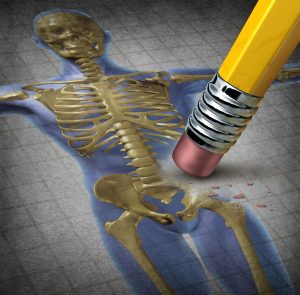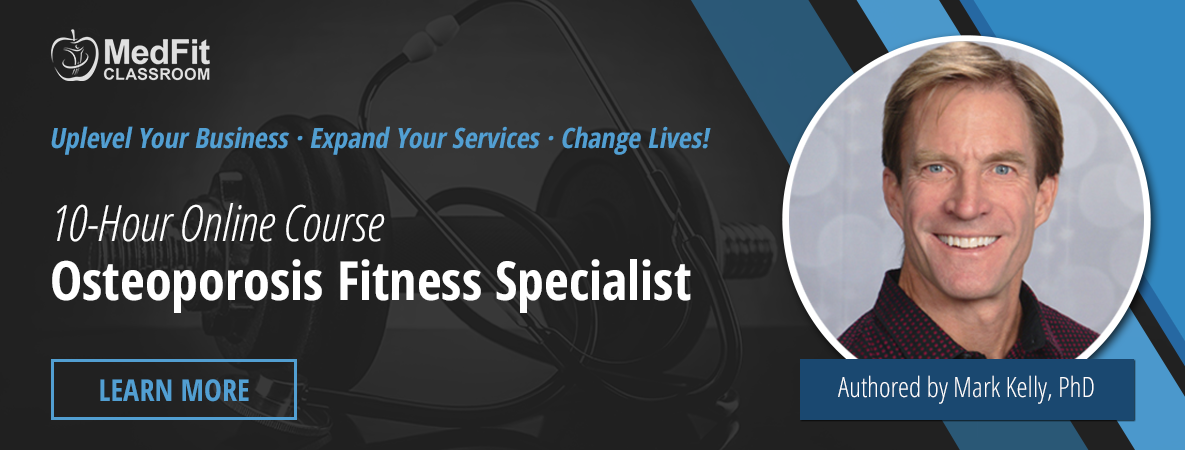I am excited to finally bring you the Osteoporosis Fitness Specialist program. It started about 3 years ago as a presentation on the MedFit Tour in Phoenix. It was then developed into a webinar, then short continuing education product, and now a full 10-hour course! It has been nicknamed Project B.O.N.E. for Beating Osteoporosis with Nutrition and Exercise.
 It is a unique course in the fitness world because it is a total turn-key format. It starts in the first module with education on bone anatomy and physiology. It then delves into what osteoporosis and osteopenia are and how our bone mass naturally changes across time. It then goes into some of the mechanisms of how bone adapts to the stresses we put on it as well as the interrelationships between joints, bones and movements and how they can improve or decrease with movement or lack of it.
It is a unique course in the fitness world because it is a total turn-key format. It starts in the first module with education on bone anatomy and physiology. It then delves into what osteoporosis and osteopenia are and how our bone mass naturally changes across time. It then goes into some of the mechanisms of how bone adapts to the stresses we put on it as well as the interrelationships between joints, bones and movements and how they can improve or decrease with movement or lack of it.
The second module goes into the role nutrients play on bone health. It is interesting that you can approach this from four different perspectives. First, you can attempt to integrate certain foods into your diet that help you obtain calcium, vitamin D, and other bone-building nutrients. Second, you can try to avoid foods that actually decrease calcium absorption and even the stores in your bone. These are termed calcium-robbing foods.
I have developed 13 short video segments that are entitled “EAT this, NOT that” to help guide people with substituting good food for a “bad food”, or one that potentially depletes calcium. Taking in the right nutrients is key because the exercises that strengthen bones are not able to do their “job” if the nutrients that can build bone are not available. Trying to change the way someone eats is one of the more difficult things in life. By making gradual changes and by substituting one food for another, the transitions become easier, and before you know it you are eating well!
The third module is about how exercise can change your bone health and why it works. One common misconception is that weightlifting is going to stress your bones more than body weight movements that use ground forces. This is simply not true. The target spots and how to work them are combined into the SHoW ME pneumonic — which informs which body parts to focus on (Spine, Hips, and Wrists) and what exercise modalities to use, with Multiplanar activity and Eccentric contractions being the best for bone-building if the client can handle it. Another pneumonic is the SAFE exercises, which represents Strength, Agility, Flexibility and Equilibrium or balance.
The fourth module is on assessments. This is one of the keys to the innovation of this program. Not only does the assessment encompass personal traits, habits, demographic and activities of daily living, but it has a comprehensive physical assessment which is named the ABCEDEFF battery. The agility, balance (both static and dynamic), coordination, dexterity or deftness, endurance, force or strength in both upper and lower regions, and flexibility in both upper and lower regions are part of this assessment program. The tests are simple to perform and the individual will fall into one of four categories, with some having male and female standards separately. The proper way to perform the assessment tests are demonstrated in videos.
The fifth module is putting it all together meaning you’re using: a) the results of your assessment and b) the client’s intake information, which includes their c) needs, limitations and preferences to combine it into a comprehensive, highly-personalized and effective. Clientas will likely not be at the same level for all the variables tested, so you may have a client who is strong but inflexible or a client that is flexible but weak. You address the weak spots and monitor progress easily.
Why is it so effective? Because the assessment will categorize the client one of four levels. Each exercise has four levels for proper progression or regression. The client is getting the right exercise for them depending on their skills, bone density and any limitations. Exercises are similar in each of the three workout venues — a gym, a park, and at home — but vary with the equipment available and surroundings. Each of these venues has pros and cons and in the current age of COVID, it is important to have alternatives to turn to.
The final module addresses some business aspects. Marketing and promoting your skills and knowledge are what keeps you in business. There must be a balance between the training skills and knowledge as well as how to manage the logistics and getting the word out.
I believe this program will set a new standard in training programs and how to carefully train a client with the knowledge gained from an assessment and thorough intake questionnaire. The disease of osteoporosis is only going to get bigger. With 54 million Americans already with low bone density, the numbers are already huge!
Dr. Mark P. Kelly has been involved with the health and fitness field for more than 30 years. He has been a research scientist for universities and many infomercial projects. He has spoken nationally and internationally on a wide variety of topics and currently speaks on the use of exercise for clinical purposes and exercise’s impact on the brain. Mark is a teacher in colleges and universities in Orange County, CA., where Principle-Centered Health- Corporate Wellness & Safety operates.

